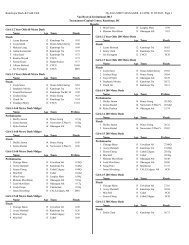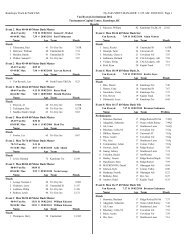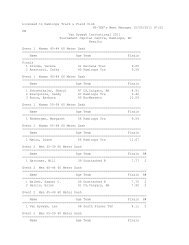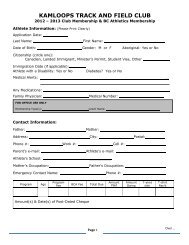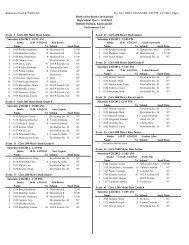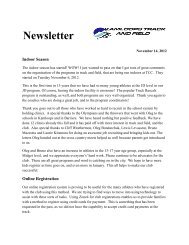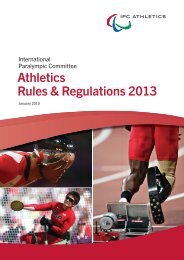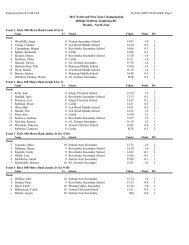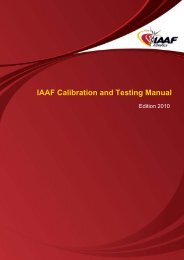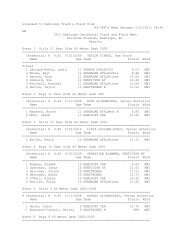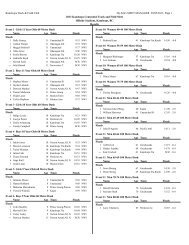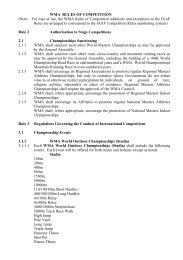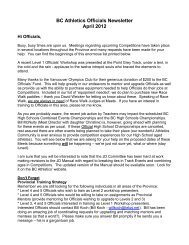Una guía para Jueces, oficiales, entrenadores y atletas
Una guía para Jueces, oficiales, entrenadores y atletas
Una guía para Jueces, oficiales, entrenadores y atletas
You also want an ePaper? Increase the reach of your titles
YUMPU automatically turns print PDFs into web optimized ePapers that Google loves.
THE CHIEF JUDGE<br />
The first task for the Chief Judge is to ensure that they have everything required to<br />
carry out their pre-race and race duties. Before the race, the course must be examined<br />
with suitable positions found for each Judge. Judges’ Record Cards, Judges’<br />
Red Cards and Judging Summary Sheets must be prepared.<br />
The Judging Panel must be informed of the important technical aspects of the events<br />
especially those that affect judging. This is done at a suitable time before the race,<br />
allowing sufficient time for Judges to take up their positions prior to the start of the<br />
race. Judges should be given a number, which will correspond to their position on<br />
the racecourse. This number will also help to identify each Judge on their red cards<br />
and on the Judging Summary Sheet.<br />
Each Judge should be supplied with a map of the course and all the information for<br />
the officials involved in the Race Walking event. All Judges should be prepared<br />
with their necessary equipment, i.e. uniform, badge or armband, record cards, red<br />
cards, yellow paddles and a suitable pen or pencil. In inclement weather, they should<br />
also have the means of keeping themselves and their documentation dry.<br />
The Judges should be introduced to the Recorder and card collectors if used and<br />
know the location of the Recorder during the race. The Chief Judge should then<br />
report to the Referee to confirm that all is in order with the judging panel.<br />
Normally, the Chief Judge will be positioned at or near the finish line during the<br />
race, particularly on a loop course. Much will depend on the type of communication<br />
system used between the Chief Judge, Chief Judge’s Assistants and Recorder.<br />
There are several ways in which communications between the Chief Judge and<br />
Judges can be carried out. Without any doubt, the important factor is the delivery<br />
of the red cards from the Judges to the Chief Judge and Recorder. This must be<br />
done with the utmost speed. Nothing is worse than having to disqualify a competitor<br />
after they have crossed the finish line. The most effective means of communication<br />
is with the chief Judge and Recorder in a fixed position, with each individual<br />
Judge having a runner/cyclist/skater to deliver the cards to the Recorder as they<br />
are filled out. After delivering the cards to the Recorder, the “runner” should return<br />
immediately to the individual Judge. On receipt of the red card, the Recorder must<br />
first examine the card to see that it is correctly completed. If the card is not correct,<br />
as to the athlete number, time, reason, and identification of the Judge, it should be<br />
returned to the Judge from whom it came. The Chief Judge should take no action<br />
until a correct card is received.<br />
Having checked that a red card has been filled in correctly, the Recorder will enter<br />
the information on the Judging Summary Sheet. The Recorder will immediately<br />
inform the Chief Judge when three red cards are recorded against any particular<br />
competitor.The Chief Judge or Chief Judge’s Assistants should then, at the earliest<br />
possible moment, disqualify that competitor.<br />
Before this notification takes place, the Chief Judge should receive the cards (at<br />
least three) back from the Recorder to check the following points:<br />
ENGLISH<br />
21



